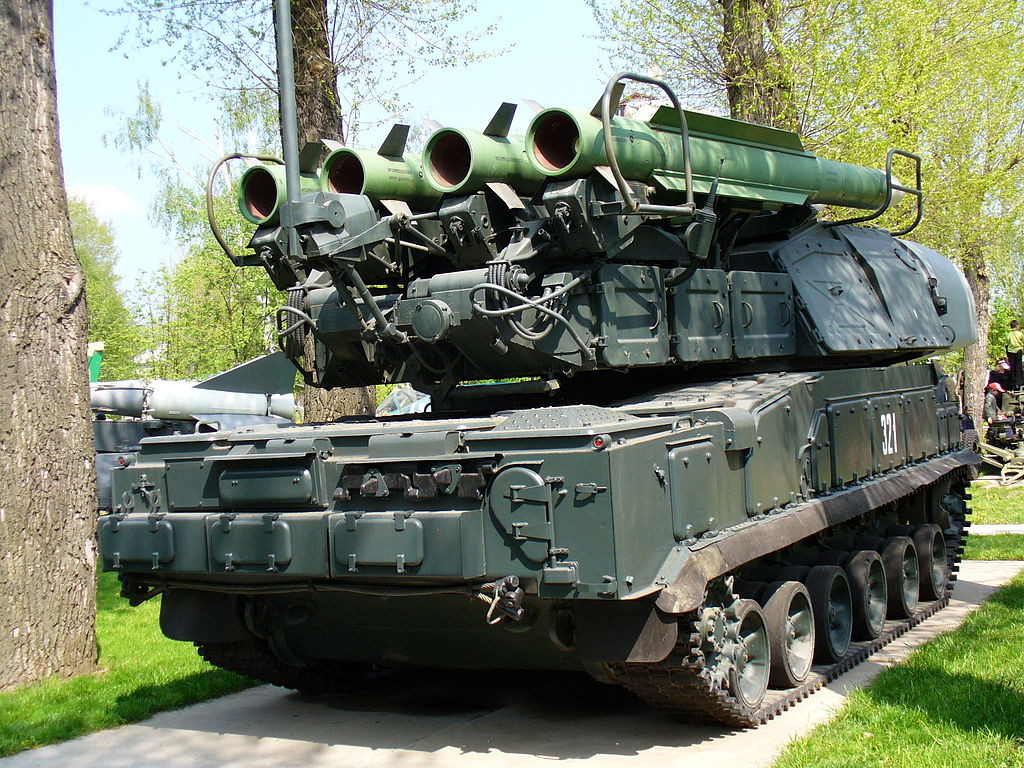The Missile Launcher that Shot Down MH17

Editor’s Note: Harry Kazianis recently spoke with Neil Gibson, an IHS Jane’s Weapons Analyst and Doug Richardson, editor of IHS Jane’s Missiles and Rockets concerning the controversial Buk self-propelled surface-to-air missile system, also known as the SA-11 Gadfly, which is alleged to have taken down Malaysia Airline Flight 17.
Kazianis: To begin, if you could, please describe in general terms the SA-11 Gadfly system. What it its primary role? How effective is it? What countries operate it? In general terms, does it have a good reputation in terms of combat capabilities compared to the competition?
Gibson: It’s a medium-range mobile air-defense system. Its role is the destruction of aircraft and some aerodynamic vehicles, the latter dependent of the version of the system and the missile used. I can’t really give you a fixed figure to how effective it is, but marketing info gives the later 9M38M1 used by the 9K37M1 Buk-M1 missile’s single-shot (single missile) kill capabilities [hit-to-kill ratios] as: aerodynamic targets (planes), 0.7 to 0.9; cruise missiles, 0.4; flying helicopters, 0.5 to 0.7; hovering helicopters, and 0.3 to 0.4. Older and newer missiles have different kill capabilities. Going by our air-defense publication, as a whole these countries use Buk systems: Belarus; Croatia; Finland; Georgia; India; North Korea; Russian Federation; Serbia; Syria; and the Ukraine. With Bangladesh, Saudi Arabia; and Venezuela having ordered more modern versions, their delivery dates unclear. As to its combat reputation, I do not known.
Kazianis: How much more capable is this system as opposed to say a shoulder fired weapons, or a MANPAD?
Gibson: I can’t really answer that as it’s a far too open a question and too many parameters, for example what MANPAD system are we comparing and what target, what range, what height, what engagement direction, etc.
That said, Buk is medium-range whereas MANPADs tend to be short-range and lower altitude, so would not threaten something operating at this altitude.
Kazianis: In terms of air defense systems, there are other more advanced systems like the S-300 or S-400. What is the difference between the SA-11 and say the S-300?
Gibson: Systems such as the S-300 and S-400 series bring much further range and far greater target engagement capabilities (type of targets and their speed), radar systems, command and control system.
Kazianis: There is also a updated version of the SA-11, the SA-17. What are the main differences between them?
Gibson: There are at least five main versions of the Buk (Russian for Beech) system: 9K37 Buk; 9K37M1 Buk-M1; 9K37M1-2 Buk-M1-2; 9K317 Buk-M2; and (most likely the) 9K317M Buk-M3. Each version of the Buk has brought in improved system components and often a new missile. The (US DOD) designation SA-11, NATO codename ‘Gadfly’, covers Buk to the Buk-M1 and uses the 9M38-based missiles. The US DOD designation SA-17, NATO codename ‘Grizzly’, covers the Buk-M1-2 and later systems armed with 9M317-based missiles.
Kazianis: There has been much speculation that the SA-11 or SA-17 was involved in the tragic incident involving MH17. Much has been made of the radar system of the SA-11 and that the operators of the system may have been firing blindly if the radar system attached was poor. Are there different variations of radar systems in each variant of these weapons? How would the operator of the system know if a potential target was civilian or military?
Richardson: When normally fielded, a Buk firing battery consists of:
- a Target Acquisition Radar vehicle used to acquire potential aerial targets, and transmit their position and tracks to:
- the Command Post (CP) vehicle (contains the missile battery’s data display and control system; digital fire-control computer, which assigns targets to individual launchers, and computes the engagement)
- one or more launchers each armed with four radar-guided missiles.
All three of these systems are vehicle-mounted.
In a normal engagement, all three would operate as an integrated weapon system, and the crew of the Command Post vehicle are likely to have a good idea of the local air activity.
However, a Buk launcher can also operate in stand-alone mode. Its built-in radar is normally used to track the target being engaged, but can be operated in a target-detection mode, allowing it to autonomously engage targets that were present in the radar’s forward field of view.
Although the launcher has its own Identification Friend or Foe (IFF) system, this is only able to establish whether the target being tracked is a friendly aircraft. It is the electronic equivalent of a sentry calling out “Who goes there?”. If there is no reply, all you know is that it is not one of your own side’s combat aircraft. Targets that do not respond to the electronic challenge could be enemy, neutral (including airliners), or friendly aircraft whose IFF transponder was not operating correctly or had not been set correctly.
So the radar would not give you a warning that it was tracking an airliner.
Harry J. Kazianis serves as a non-resident Senior fellow at the China Policy Institute as well as a WSD-Handa Fellow for CSIS:PACNET. He is also Managing Editor for the Washington, DC based international affairs publication The National Interest.
Photo credit: George Chernilevsky

